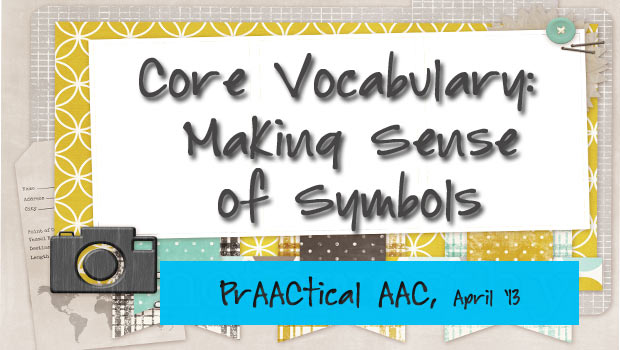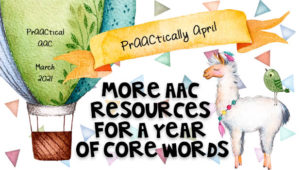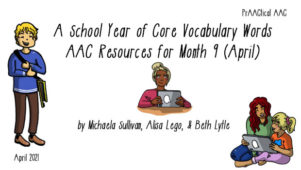Core Vocabulary: Making Sense of Symbols

Take a look at these pictures and try to guess their meanings.
Now do it again with these symbols.
One more time with the symbols below.
We’re not gamblers by nature, but if we had to bet we’d say that you had a pretty easy time guessing the first two rows (backpack, banana, bathroom; sleep, wash, eat) and struggled with the last row (know, she, was/were). That presents a bit of a problem, actually, because it’s that last hard-to-guess row that contains important core vocabulary. And these kinds of core words are the ones we need to use frequently during the day. Looks like we have a bit of a dilemma: The symbols that are least transparent are important ones to teach.
We often hear SLPs say that they want concrete symbols for some of their clients with AAC needs. We can certainly make that happen for some object nouns, action verbs, and descriptors. But beyond that, it’s just not possible. There is no concrete way to represent abstract concepts. And lots of the words we need to use throughout the day are abstract. However you slice it, and whichever symbol set or system you choose, there just is no concrete way to represent many of these words. So, we can either avoid teaching those words altogether or accept the fact that the symbols are going to be fairly abstract. In most cases, avoiding those words leads to even bigger problems, so core vocabulary (and their symbols) is worth the effort.
Nonetheless, teaching abstract symbols takes some thought. Here are some suggestions and things to think about in planning your intervention. As we all know, people who are learning AAC are a diverse bunch, so not all of these ideas are a good fit for any single person.
- Talk about the symbols: Symbols are different from words or concepts. We don’t think about that much when the symbol is transparent (like in the first two rows). But that’s not the case when the symbol is translucent (i.e., after we tell you what it means, it makes sense) or opaque (i.e., doesn’t have any resemblance to the word or concept; seems arbitrary). In those instances, it makes sense to begin to talk about the symbols and help the learner understand why that particular symbol means that particular thing. Metalinguistics, thinking and talking about language, can help the learner make sense of abstraction.
- Point out the relationship between the symbol and the referent: Look at the symbol together and talk about what makes that symbol mean that particular thing. Sometimes what is obvious to us (e.g., a heart representing positive emotion) is not at all obvious to the AAC learners with whom we work. Help them make that connection. “Look-this one is love. She’s hugging her baby ‘cause she loves him. Like I hug you. [pauses to hug]” “See the hearts? You made me a Valentine with hearts. It said, ‘I love you.’ I love you and [points to symbol], I love to hug you.” Make association and then refer to them as you’re teaching and practicing the word.
- Make it personal: Relate the symbol to things in the learner’s own life.
- Keep words (represented by symbols) in the same place: If your client has communication tools with the same word on different screens, overlays, or pages, do whatever you can to keep the location consistent. We’ve all had the experience of needing something and not remembering the name, but being able to access it because we knew where to find it. (It happened to me just this weekend. I couldn’t think of the word ‘awl’ to save my life, but because I knew where it was, my word-finding issue didn’t hold me back.) Location cues can help with retrieval, but only if we keep things consistent.
- Create a teaching activity with an emotional experience: Make it silly, exciting, suspenseful, surprising, etc. If you can find a way to interact with this symbol that has an emotional component, learning and retention will be stronger.
- Create lots of practice opportunities: Frequent experiences with the new symbols and words will build fluency. The more practice we provide, the faster and easier it will be for our clients who use AAC to recognize the symbols when they are trying to say a particular word.
Lastly, don’t assume that because the symbols are abstract that people with intellectual disabilities can’t learn them. They can. They do. You don’t have to take our word for it. Read the longitudinal research by done in the 1990’s (and beyond) by Mary Ann Romski and Rose Sevcik for starters. They intentionally selected abstract symbols for their AAC intervention and demonstrated that people with significant learning challenges can use abstract symbols successfully.
—
Romski, M.A., & Sevcik, R.A. (1996). Breaking the Speech Barrier: Language Development Through Augmented Means. Paul H. Brookes Publishing Company.
Symbols from the Pixon Project Kit.
Filed under: PrAACtical Thinking
Tagged With: abstract, core language, core vocabulary, semantics, symbols
This post was written by Carole Zangari








2 Comments
I am going to put this out there as an SLP who works mostly with autistic individuals. I am neurodivergent myself, and am also a concrete and literal thinker who needs, at times, to get clarity about what nuanced, vague, abstract and/or ambiguous language means. I coach my adults on advocating for others to use more direct language with them and balance this with helping them break down the potential meaning(s) of abstract language. In light of this, I am asking the question, why prioritize core words over concrete labels? In my practice, I look to expand my clients’ vocabulary of people, items, locations, and I introduce core words, and many action words, in relation to this expanding vocabulary set. Having an extended vocabulary is so important, and I feel that, by prioritizing core words, we are tipping the scales towards efficiency of communicative functions versus presuming that the child can learn to use a robust vocabulary. While ancedotal, my experience has been that my clients (especially my autistic early language learners) have experienced more success, independence , and comfort with AAC when introduced to customized, specific language first, with more abstract words being chained on later. Does AAC always have to have a top-down vs. bottom-up approach?
Marie, thank you for your comment and question. I agree that specific words are important to teach, and the question is one of timing (when to teach general vs specific) and balance (how much of each). I think there is a misconception among some that core words are the very first words to teach beginning communicators. That may be true in some cases, but usually the first words we teach are those with a lot of personal meaning and connection for the AAC user. On the other end, once a person has some ability to use AAC to express themselves, we should absolutely be focusing on instruction for words that are more specific to help them build rich vocabularies (not just ‘angry/mad’ but also annoyed, disappointed, frustrated, aggravated, furious, etc). Efficiency may take priority in the early stages, but we can never discount the importance of challenging people to meet their true linguistic potential. With adequate supports and services, they are generally way more capable than they may have seemed at the beginning. But we won’t ever know unless we provide them with high-quality language intervention at the advanced levels. This extends beyond vocabulary and into things like complex sentences, narrative development, non-literal language, inferencing, etc. These are necessary for many AAC users to achieve their potential and succeeed academically and beyond the school years.